2024届高考英语专题复习阅读理解之说明文解题策略 优质课课件(共25张PPT)
文档属性
| 名称 | 2024届高考英语专题复习阅读理解之说明文解题策略 优质课课件(共25张PPT) | 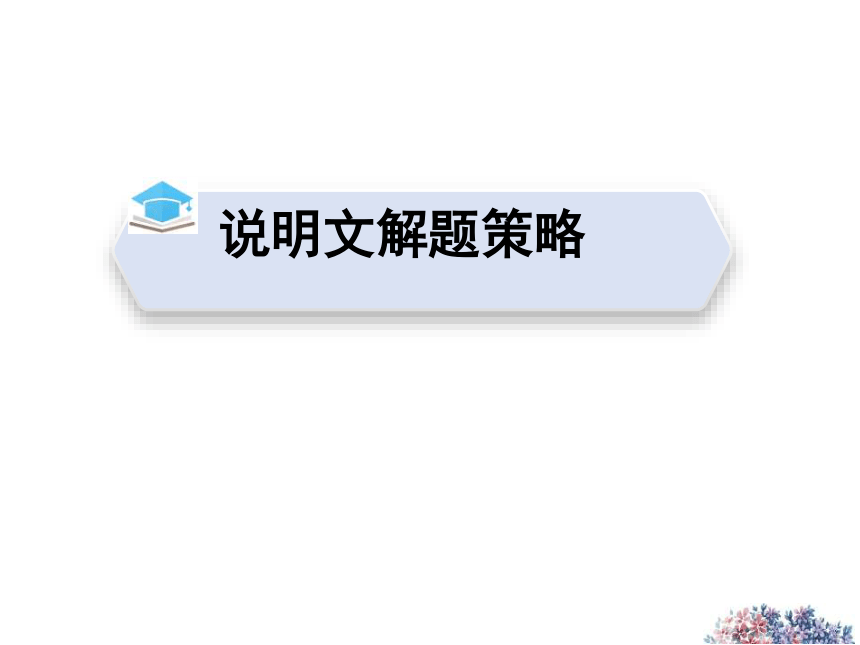 | |
| 格式 | pptx | ||
| 文件大小 | 839.8KB | ||
| 资源类型 | 教案 | ||
| 版本资源 | 通用版 | ||
| 科目 | 英语 | ||
| 更新时间 | 2023-12-24 12:53:38 | ||
图片预览


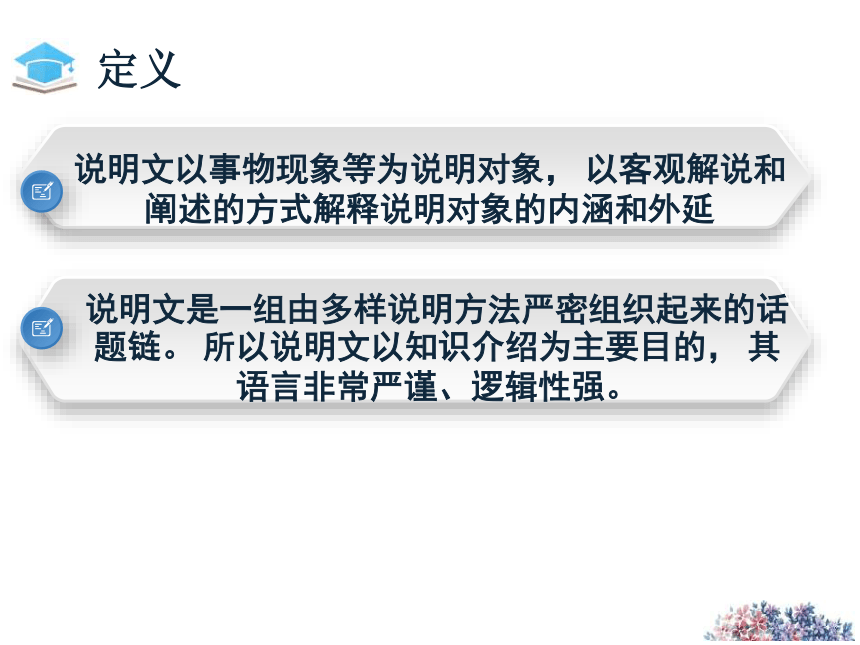

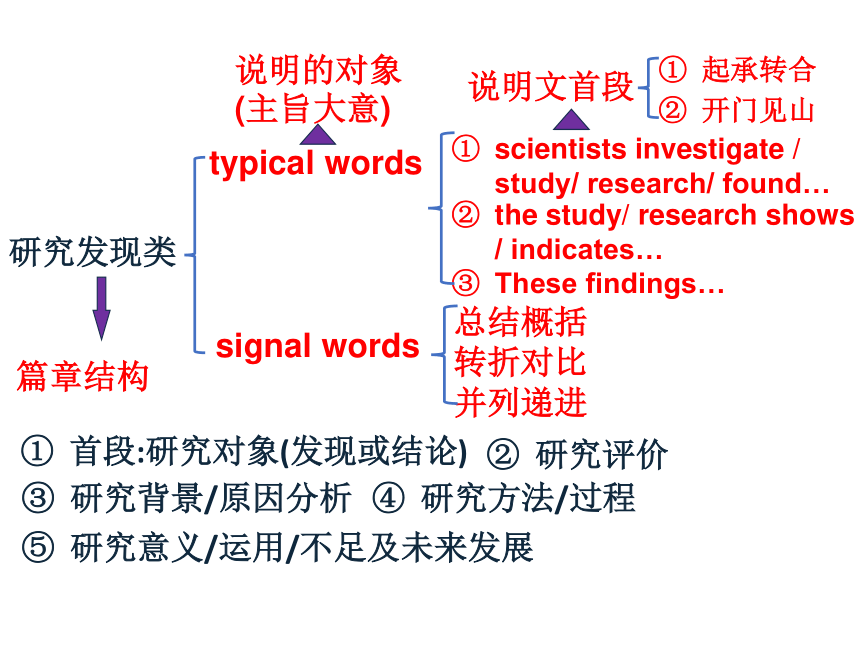
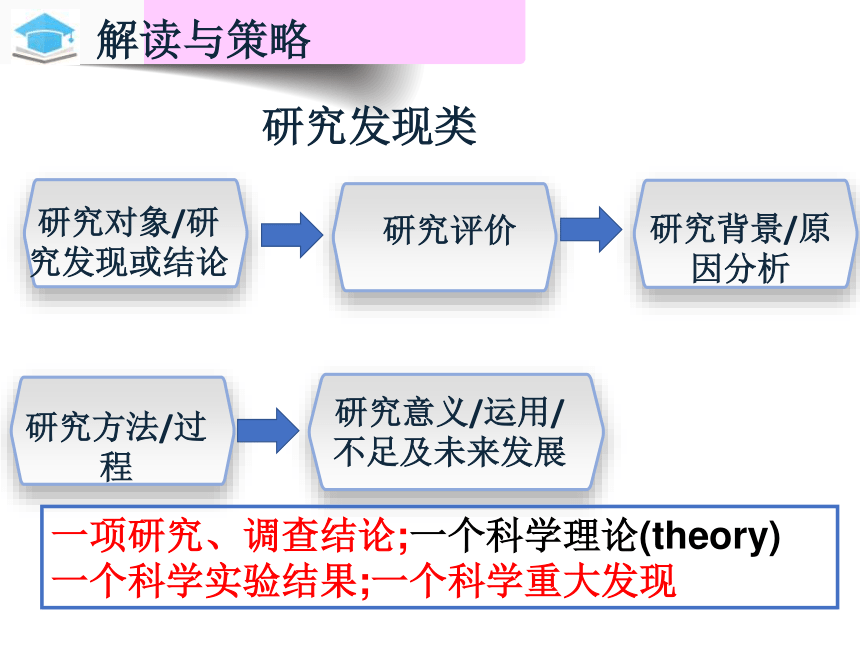

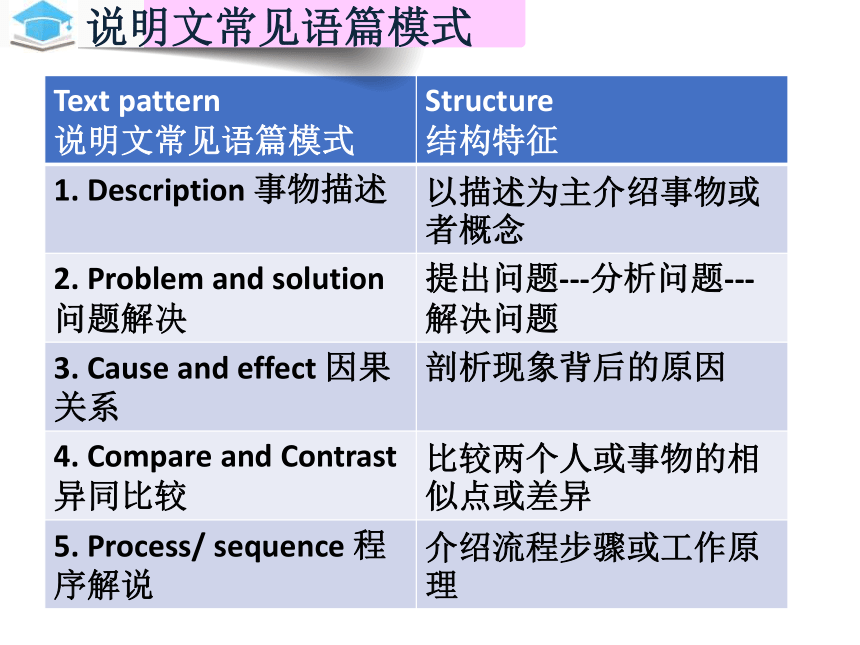
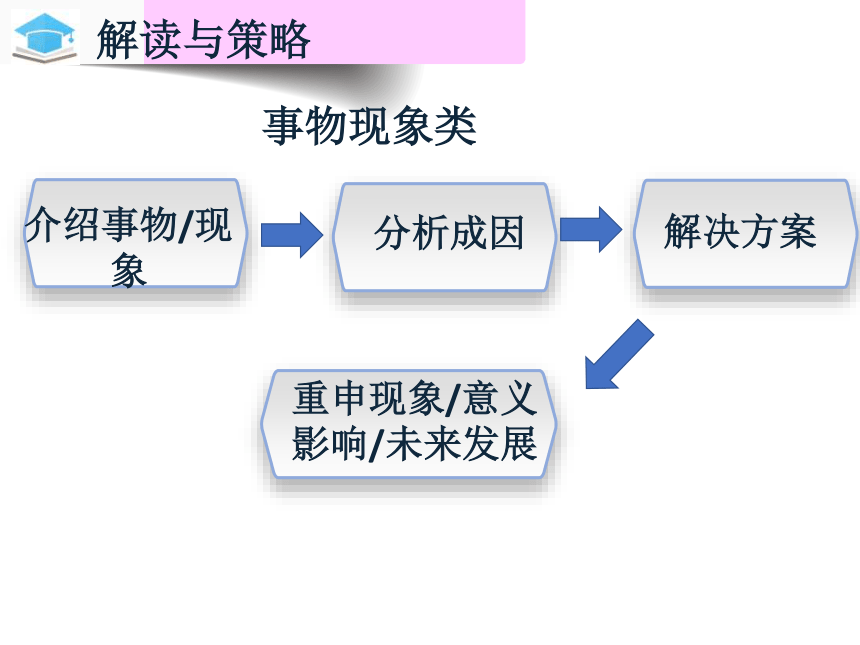
文档简介
(共25张PPT)
说明文解题策略
说明文解题技巧
难点与困惑
解读与策略
训练方法
定义与分类
定义
说明文以事物现象等为说明对象, 以客观解说和阐述的方式解释说明对象的内涵和外延
说明文是一组由多样说明方法严密组织起来的话题链。 所以说明文以知识介绍为主要目的, 其语言非常严谨、逻辑性强。
分类
研究发现类
事物现象类
一项研究、调查结论;一个科学理论
一个科学实验结果;一个科学重大发现
一项新的科技产品
难点与困惑
语篇长、难句多、词汇生
研究发现类
typical words
signal words
篇章结构
scientists investigate / study/ research/ found…
总结概括
转折对比
并列递进
the study/ research shows / indicates…
These findings…
起承转合
开门见山
说明的对象(主旨大意)
说明文首段
研究评价
研究背景/原因分析
研究方法/过程
研究意义/运用/不足及未来发展
首段:研究对象(发现或结论)
研究对象/研
究发现或结论
解读与策略
研究评价
研究背景/原
因分析
研究方法/过
程
研究意义/运用/不足及未来发展
研究发现类
一项研究、调查结论;一个科学理论(theory)
一个科学实验结果;一个科学重大发现
说明文的写作手法
1. 定义法 Giving a definition
2. 例证法 Providing examples
3. 数据法 Showing statistics
4. 比较法 Making contrast and comparison
5. 诠释法 Making explanations
6.引用法 Quoting and presenting experiments
7.因果法 Analyzing the cause and effect
说明文常见写作手法
Text pattern 说明文常见语篇模式 Structure
结构特征
1. Description 事物描述 以描述为主介绍事物或者概念
2. Problem and solution 问题解决 提出问题---分析问题---解决问题
3. Cause and effect 因果关系 剖析现象背后的原因
4. Compare and Contrast异同比较 比较两个人或事物的相似点或差异
5. Process/ sequence 程序解说 介绍流程步骤或工作原理
说明文常见语篇模式
介绍事物/现象
解读与策略
分析成因
解决方案
重申现象/意义影响/未来发展
事物现象类
介绍说明对象
解读与策略
产品特征、优势等
研发背景(同类型产品对比)
其他领域的运用
不足(挑战)及未来发展前景
研究发现类
介绍一项新的科技产品
(产品的外形/材质/功能/工作原理)
Introduction
说明文语篇模式
Conclusion
Briefly state the
main ideas which
will be explained
in the body part.
Body
Introduction
1. Arouse the interest of the readers.
Contain the topic
sentence of the essay
2. Introduce the topic of the text
The function of the introduction
Introduction
说明文首段写作模式
层进式
(起承转合)
概括总结
总分
说明文解题技巧
句间逻辑关系
说明文语篇结构
说明文语篇结构
more than half of Australian homes are still paying for a landline(座机)
Age is naturally a factor.
It’s also to do with makeup of your household.
How long until they go the way of gas street lamps and morning milk deliveries
Para. 1
Para. 2
Para. 5
Para. 6
Not really necessary and keep it as a security blanket
Para. 3
Para. 4
Para. 5
Mobile phone is widely popular with younger kids
事物现象类(2021全乙卷)
介绍事物/现象
说明文语篇结构
分析成因
总结评价(未来发展)
事物现象类
文化信息解读
Generation Ys :
Generation Xers:
Baby Boomers:
gas street lamps and morning milk deliveries
the group of people who were born in the 1980s and early 1990
a person who was born during a baby boom, which happened in the UK and the US
between 1945 and 1965
the group of people who were born in the 1960s and1970s
事物现象类(2021全乙卷)
When almost everyone has a mobile phone, why are more than half of Australian homes still paying for a landline(座机)
These days you’d be hard pressed to find anyone in Australia over the age of 15 who doesn’t own a mobile phone. In fact plenty of younger kids have one in their pocket. Practically everyone can make and receive calls anywhere, anytime.
Still, 55 percent of Australians have a landline phone at home and only just over a quarter (29%) rely only on their smartphones, according to a survey(调查). Of those Australians who still have a landline, a third concede that it’s not really necessary and they’re keeping it as a security blanket — 19 percent say they never use it while a further 13 percent keep it in case of emergencies. I think my home falls into that category.
解读与策略
事物现象类(2021全乙卷)
When almost everyone has a mobile phone, why are more than half of Australian homes still paying for a landline(座机)
These days you’d be hard pressed to find anyone in Australia over the age of 15 who doesn’t own a mobile phone. In fact plenty of younger kids have one in their pocket. Practically everyone can make and receive calls anywhere, anytime.
Still, 55 percent of Australians have a landline phone at home and only just over a quarter (29%) rely only on their smartphones, according to a survey(调查). Of those Australians who still have a landline, a third concede that it’s not really necessary and they’re keeping it as a security blanket — 19 percent say they never use it while a further 13 percent keep it in case of emergencies. I think my home falls into that category.
解读与策略
More than half of Australian homes are still choosing to stick with their home phone. Age is naturally a factor(因素) — only 58 percent of Generation Ys still use landlines now and then, compared to 84 percent of Baby Boomers who’ve perhaps had the same home number for 50 years. Age isn’t the only factor; I’d say it’s also to do with the makeup of your household.
解读与策略
事物现象类(2021全乙卷)
More than half of Australian homes are still choosing to stick with their home phone. Age is naturally a factor(因素) — only 58 percent of Generation Ys still use landlines now and then, compared to 84 percent of Baby Boomers who’ve perhaps had the same home number for 50 years. Age isn’t the only factor; I’d say it’s also to do with the makeup of your household.
解读与策略
事物现象类(2021全乙卷)
Generation Xers with young families, like my wife and I, can still find it convenient to have a home phone rather than providing a mobile phone for every family member. That said, to be honest the only people who ever ring our home phone are our Baby Boomers parents, to the point where we play a game and guess who is calling before we pick up the phone (using Caller ID would take the fun out of it).
解读与策略
事物现象类(2021全乙卷)
How attached are you to your landline How long until they go the way of gas street lamps and morning milk deliveries
解读与策略
事物现象类(2021全乙卷)
介绍事物/现象
说明文语篇结构
分析成因
未来发展
事物现象类
more than half of Australian homes are still paying for a landline(座机)
Age is naturally a factor.
It’s also to do with makeup of your household.
How long until they go the way of gas street lamps and morning milk deliveries
Para. 1-3
Para. 4
Para. 5
Para. 6
训练方法
放松心情、限时阅读
抓大放小、理顺思路
勤练善思、摸索提升
Thank you !
说明文解题策略
说明文解题技巧
难点与困惑
解读与策略
训练方法
定义与分类
定义
说明文以事物现象等为说明对象, 以客观解说和阐述的方式解释说明对象的内涵和外延
说明文是一组由多样说明方法严密组织起来的话题链。 所以说明文以知识介绍为主要目的, 其语言非常严谨、逻辑性强。
分类
研究发现类
事物现象类
一项研究、调查结论;一个科学理论
一个科学实验结果;一个科学重大发现
一项新的科技产品
难点与困惑
语篇长、难句多、词汇生
研究发现类
typical words
signal words
篇章结构
scientists investigate / study/ research/ found…
总结概括
转折对比
并列递进
the study/ research shows / indicates…
These findings…
起承转合
开门见山
说明的对象(主旨大意)
说明文首段
研究评价
研究背景/原因分析
研究方法/过程
研究意义/运用/不足及未来发展
首段:研究对象(发现或结论)
研究对象/研
究发现或结论
解读与策略
研究评价
研究背景/原
因分析
研究方法/过
程
研究意义/运用/不足及未来发展
研究发现类
一项研究、调查结论;一个科学理论(theory)
一个科学实验结果;一个科学重大发现
说明文的写作手法
1. 定义法 Giving a definition
2. 例证法 Providing examples
3. 数据法 Showing statistics
4. 比较法 Making contrast and comparison
5. 诠释法 Making explanations
6.引用法 Quoting and presenting experiments
7.因果法 Analyzing the cause and effect
说明文常见写作手法
Text pattern 说明文常见语篇模式 Structure
结构特征
1. Description 事物描述 以描述为主介绍事物或者概念
2. Problem and solution 问题解决 提出问题---分析问题---解决问题
3. Cause and effect 因果关系 剖析现象背后的原因
4. Compare and Contrast异同比较 比较两个人或事物的相似点或差异
5. Process/ sequence 程序解说 介绍流程步骤或工作原理
说明文常见语篇模式
介绍事物/现象
解读与策略
分析成因
解决方案
重申现象/意义影响/未来发展
事物现象类
介绍说明对象
解读与策略
产品特征、优势等
研发背景(同类型产品对比)
其他领域的运用
不足(挑战)及未来发展前景
研究发现类
介绍一项新的科技产品
(产品的外形/材质/功能/工作原理)
Introduction
说明文语篇模式
Conclusion
Briefly state the
main ideas which
will be explained
in the body part.
Body
Introduction
1. Arouse the interest of the readers.
Contain the topic
sentence of the essay
2. Introduce the topic of the text
The function of the introduction
Introduction
说明文首段写作模式
层进式
(起承转合)
概括总结
总分
说明文解题技巧
句间逻辑关系
说明文语篇结构
说明文语篇结构
more than half of Australian homes are still paying for a landline(座机)
Age is naturally a factor.
It’s also to do with makeup of your household.
How long until they go the way of gas street lamps and morning milk deliveries
Para. 1
Para. 2
Para. 5
Para. 6
Not really necessary and keep it as a security blanket
Para. 3
Para. 4
Para. 5
Mobile phone is widely popular with younger kids
事物现象类(2021全乙卷)
介绍事物/现象
说明文语篇结构
分析成因
总结评价(未来发展)
事物现象类
文化信息解读
Generation Ys :
Generation Xers:
Baby Boomers:
gas street lamps and morning milk deliveries
the group of people who were born in the 1980s and early 1990
a person who was born during a baby boom, which happened in the UK and the US
between 1945 and 1965
the group of people who were born in the 1960s and1970s
事物现象类(2021全乙卷)
When almost everyone has a mobile phone, why are more than half of Australian homes still paying for a landline(座机)
These days you’d be hard pressed to find anyone in Australia over the age of 15 who doesn’t own a mobile phone. In fact plenty of younger kids have one in their pocket. Practically everyone can make and receive calls anywhere, anytime.
Still, 55 percent of Australians have a landline phone at home and only just over a quarter (29%) rely only on their smartphones, according to a survey(调查). Of those Australians who still have a landline, a third concede that it’s not really necessary and they’re keeping it as a security blanket — 19 percent say they never use it while a further 13 percent keep it in case of emergencies. I think my home falls into that category.
解读与策略
事物现象类(2021全乙卷)
When almost everyone has a mobile phone, why are more than half of Australian homes still paying for a landline(座机)
These days you’d be hard pressed to find anyone in Australia over the age of 15 who doesn’t own a mobile phone. In fact plenty of younger kids have one in their pocket. Practically everyone can make and receive calls anywhere, anytime.
Still, 55 percent of Australians have a landline phone at home and only just over a quarter (29%) rely only on their smartphones, according to a survey(调查). Of those Australians who still have a landline, a third concede that it’s not really necessary and they’re keeping it as a security blanket — 19 percent say they never use it while a further 13 percent keep it in case of emergencies. I think my home falls into that category.
解读与策略
More than half of Australian homes are still choosing to stick with their home phone. Age is naturally a factor(因素) — only 58 percent of Generation Ys still use landlines now and then, compared to 84 percent of Baby Boomers who’ve perhaps had the same home number for 50 years. Age isn’t the only factor; I’d say it’s also to do with the makeup of your household.
解读与策略
事物现象类(2021全乙卷)
More than half of Australian homes are still choosing to stick with their home phone. Age is naturally a factor(因素) — only 58 percent of Generation Ys still use landlines now and then, compared to 84 percent of Baby Boomers who’ve perhaps had the same home number for 50 years. Age isn’t the only factor; I’d say it’s also to do with the makeup of your household.
解读与策略
事物现象类(2021全乙卷)
Generation Xers with young families, like my wife and I, can still find it convenient to have a home phone rather than providing a mobile phone for every family member. That said, to be honest the only people who ever ring our home phone are our Baby Boomers parents, to the point where we play a game and guess who is calling before we pick up the phone (using Caller ID would take the fun out of it).
解读与策略
事物现象类(2021全乙卷)
How attached are you to your landline How long until they go the way of gas street lamps and morning milk deliveries
解读与策略
事物现象类(2021全乙卷)
介绍事物/现象
说明文语篇结构
分析成因
未来发展
事物现象类
more than half of Australian homes are still paying for a landline(座机)
Age is naturally a factor.
It’s also to do with makeup of your household.
How long until they go the way of gas street lamps and morning milk deliveries
Para. 1-3
Para. 4
Para. 5
Para. 6
训练方法
放松心情、限时阅读
抓大放小、理顺思路
勤练善思、摸索提升
Thank you !
